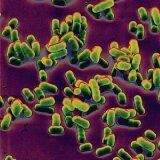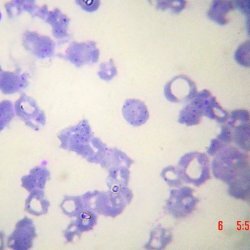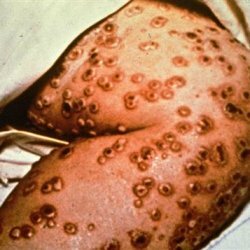Plague: symptoms, treatment, prevention

Plague is a serious infectious disease, the causative agent of which is Gram-negative bacteria Yersinia pestis or plague rod. The main reservoir and source of bacteria in nature are various rodents: gerbils, ground squirrels, marmots, lagiformes and mice. The bacterium is usually transmitted from rodents to humans through flea bites, and the infection can be transmitted by treating the skin or eating the meat of an infected animal. Between people, the infection can be transmitted by airborne droplets. The human body is very susceptible to the plague, so even a single infection previously easily evolved into a monstrous epidemic. Therefore, it is important to know the symptoms, treatment and ways to prevent plague.
The plague is rightfully considered to be the most dangerous for health and life infectious disease. Until now, a huge number of foci of plague in the Americas, India, Africa and Central Asia have been preserved.
This disease has left a notable mark in the history of mankind and became a symbol of death. Since ancient times, mankind is familiar with the plague, there are data on outbreaks of the disease, which turned into terrible epidemics in the past. And in some cases, epidemics outgrew the pandemic. There are three known cases of the plague pandemic:
- Justinian plague - devastated the Eastern Roman Empire and Egypt in the period 527-565.
- Black or great death - raged in the territory of Crimea, Western Europe and the Mediterranean. About 60 million people died from it. It is known as the most terrible pandemic in the history of mankind.
- The Hong Kong pandemic began in Hong Kong, after which it spread to India. It began in 1895 and claimed 12 million lives. It was during this pandemic that the causative agent was finally identified and the role of rats in the spread of infection was proved. Thanks to this, prevention was organized. The causative agent of the plague, independently of each other, was discovered by Sh. Kitaizato along with A. Jersen and GN Minh. In Russia, plague epidemics have occurred more than once, since the fourteenth century. In the study of the disease, a great contribution was made by Russian scientists NN Klodnitsky, DK Zabolotny, NF Gamaley, II Mechnikov and others.
Symptoms of
There are several basic forms of plague, it is pulmonary( the most dangerous form of the disease for others, as the patient can infect a huge number of people), septic and bubonic forms. In most cases, the disease manifests itself immediately with a strong temperature increase( up to 40 degrees, and sometimes 42).A fever begins, the person becomes fussy and restless, sometimes there may be a desire to escape somewhere and fear. The tongue becomes swollen, a white coating appears, in some cases a tremor of the tongue begins. The infected person is concerned about weakness, headaches and dizziness, severe chills, vomiting and nausea, as well as impaired coordination of movements, speech and gait. May begin hallucinations, delirium and insomnia, pulse arrhythmia, dyspnea. In some cases, at the site of penetration of the bacteria, a spot develops on the skin, which develops into a pustule. Pustule differs morbidity and after a while disappears, leaving a slowly healing ulcer. Secondary buboes also begin to appear.
Complications of
In about 10% of cases, the infected person begins developing gangrene of the skin, fingers or feet. And in almost all cases the plague causes disseminated intravascular coagulation( DVS-syndrome).
Diagnosis
The clinical manifestations of plague play the most important role in the diagnosis. In addition, a study of separated ulcers and bubo.
Treatment of
Fortunately, nowadays the plague is quite amenable to treatment, if in time to see a doctor. Proper treatment, prevention and diagnosis of plague can save lives and preserve health. At the first signs of the disease the patient should be immediately hospitalized in a specialized infectious hospital. Antibacterial agents are mainly used for treatment. Used etiotropic therapy with drugs such as levomycetin, streptomycin and ampicillin, which are administered at the maximum dose. Detoxication therapy is also provided.
Prevention
Do not forget that the plague is a very dangerous disease and in the absence of timely treatment, it very often leads to death in just 3-5 days. Therefore, knowing that such treatment, symptoms and diagnosis of plague is not enough for safety. No less important are preventive measures. Prevention usually consists of fighting rodents and fighting with rats is especially important, so if you notice rats near your house or at the cottage, try to survive from there. If a person works with materials that can be contagious, then he should be constantly observed by a doctor.
At the state level, preventive measures are the constant monitoring of the state of probable natural foci of the disease, as well as control over the possibility of importation of infection from abroad. In addition, in places where people live near natural foci of the plague, explanatory work is carried out to raise awareness of the local population about preventive measures and symptoms of the disease. In some cases, the population is vaccinated.
Very great importance is given to early detection of the first cases of infection among people. It is extremely important to report to the health authorities if there is a suspicion of a plague. A doctor who accepts a person who suspects a plague must immediately stop receiving patients, close windows, doors and do everything to stop the movement of other people near the office where the patient is. All people who have come into contact with the patient are identified, and preventive treatment is provided for them. It can even go so far as to ensure that all the local population is vaccinated.
So, we figured out what plague, symptoms, treatment, prevention and diagnosis of this dangerous disease, and therefore, are armed to deal with it.



